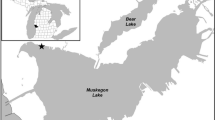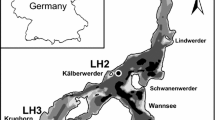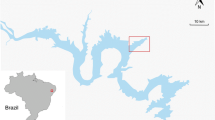Abstract
The Florida Everglades is an oligotrophic, phosphorus (P)-limited wetland that is experiencing eutrophication as a result of P-enriched agricultural runoff. Effects of P enrichment on diel water-column dissolved oxygen concentration (DO) profiles were measured along nutrient gradients downstream of agricultural discharges in two northern Everglades marshes and in field enclosures (mesocosms) exposed to different P loading rates. Reference (i.e., water-column TP < 10 μg/L) areas in the marsh interior were characterized by strong diel fluctuations in DO, and aerobic conditions generally were maintained throughout the diel cycle. Enriched stations (water-column TP elevated to between 12 and 131 μg/L) were characterized by dampened diel fluctuations and reduced DO, and the extent of these changes was correlated strongly with marsh P concentrations. Mean DO declined from between 1.81 and 7.52 mg/L at reference stations to between 0.04 and 3.18 mg/L in highly enriched areas. Similarly, minimum DO declined from between 0.33 and 5.86 mg/L to between 0 and 0.84 mg/L with increasing enrichment, and the frequency of extremely low DO (< 1 mg/L) increased from between 0 and 20% to as high as 100% in the most enriched areas. Diel oxygen profiles in P-enriched mesocosms declined progressively with time; all loading treatments exhibited similar DO during the 1st year of P loading, but concentrations declined significantly at higher loads by year 3. Reductions in water-column DO with increased P enrichment were associated with reduced oxygen production by submersed periphyton and macrophytes and increased sediment oxygen demand. Increased emergent macrophyte cover in enriched areas likely contributed to these changes by shading the water-column, which inhibited submerged productivity, and by providing inputs of nutrient-rich detritus, which increased oxygen demand. Declines in marsh DO are associated with other ecological changes such as increased anaerobic metabolism and an increase in invertebrate taxa that tolerate low DO. While background oxygen concentrations in wetlands can be lower than those in lakes and rivers, declines in water-column DO caused by eutrophication can result in biological impacts similar to those in other aquatic ecosystems.
Similar content being viewed by others
References
Belanger T.V., Dierberg F.E. and Roberts J. 1985. Dissolved oxygen concentrations in Florida's humic-colored waters and water quality standard implications. Florida Scientist 48: 96–107.
Belanger T.V. and Platko J.R. II 1986. Dissolved Oxygen Budgets in the EvergladesWater Conservation Area 2A. Technical report to the South Florida Water Management District. West Palm Beach, Florida, USA.
Belanger T.V., Scheidt D.J. and Platko J.R. II 1989. Effects of macnutrient enrichment on the Florida Everglades. Lake and Reser-voir Management 5: 101–111.
Bosserman R.W. 1984. Diurnal variation of water chemistry paramenrichment-eters in Okefenokee Swamp. In: Cohen A.D., Casagrande D.J., Andrejko M.J. and Best G.R. (eds), The Okefenokee Swamp: Its Natural History, Geology, and Geochemistry.Wetland Surveys, Los Alamos, New Mexico, USA, pp. 296–319.
Brightman R.S. 1984. Benthic macroinvertebrate response to sec-ondarily treated wastewater in north-central Florida cypress domes. In: Ewel K.C. and Odum H.T. (eds), Cypress Swamps. University of Florida Press, Gainesville, Florida, USA, pp. 186– 196.
Brooks R.P. and Hughes R.M. 1988. Guidelines for assessing the biotic communities of freshwater wetlands. In: Kusler J.A., Quammen M.L. and Brooks G. (eds), Proceedings of the Nationsensitive al Wetlands Symposium: Mitigation of Impacts and Losses. ASWM Technical Report. Berne, NY, USA, pp. 276–282.
Browder J., Cottrell A.D., Brown M., Newman M., Edwards R., Yeska J. et al. 1982. Biomass and Primary Production of Mi-crophytes and Macrophytes in Periphyton Habitats of the South-ern Everglades. Report T-662. South Florida Research Center, Homestead, Florida, USA.
Browder J.A., Gleason P.J. and Swift D.R. 1994. Periphyton in the Everglades: spatial variation, environmental correlates, and waterecological implications. In: Davis S.M. and Ogden J.C. (eds), Everglades: The Ecosystem and its Restoration. St. Lucie Press, Delray Beach, Florida, USA, pp. 379–418.
Brown M., Brandt K. and Adamus P. 1989. Indicators of Wetland Ecological Condition: Proposals for a National Ecological Moni toring and Assessment Program. Report to the Office of Research and Development. United States Environmental Protection Agency.
Bryan C.F. and Sabins D.S. 1979. Management implications in Analywater quality and fish standing stock information in the At-chafalaya River basin, Louisiana. In: Day J.W. Jr, Culley D.D. Jr, Turner R.E. and Mumphrey A.J. Jr (eds), Proceedings of the Third Coastal Marsh and Estuary Management Symposium. Louisiana State University, Baton Rouge, Louisiana, USA, pp. 293–316.
Carpenter S., Caraco N.F., Correll D.L., Howarth R.W., Sharpley A.N. and Smith V.H. 1998. Nonpoint Pollution of SurfaceWaters with Phosphorus and Nitrogen. Issues in Ecology No. 3. Ecologi-cal Society of America, Washington, D.C., USA.
Cosser P.R. 1989.Water quality, sediments and the macroinverteb-rate community of residential canal estates in south-east Queens-land, Australia: a multivariate analysis. Water Research 23: 1087–1097.
Davis S.M. 1991. Growth, decomposition, and nutrient retention of Cladium jamaicense Crantz and Typha domingensis Pers. in the Florida Everglades. Aquatic Botany 40: 203–224.
DeBusk W.F. and Reddy K.R. 1998. Turnover of detrital organic carbon in a nutrient-impacted Everglades marsh. Soil Science Society of America Journal 62: 1460–1468.
Doren R.F., Armentano T.V., Whiteaker L.D. and Jones R.D. 1997. Marsh vegetation patterns and soil phosphorus gradients in the Everglades ecosystem. Aquatic Botany 56: 145–163.
Fisher M.M. 1997. Estimating landscape scale flux of phosphorus using geographical information systems (GIS), University of Florida, Gainesville, Florida, USA.
Florida Department of Environmental Protection 1996. Surface Water Quality Standards. Chapter 62–302 Florida Administra-NorthAmeritive Code, Tallahassee, Florida, USA.
Godfrey P.J., Kaynor E.R., Pelczarski S. and Benforado J. (eds) 1985. Ecolgical Considerations in Wetlands Treatment of Municipal Wastewaters.Van Nostrand Reinhold Co., New York, New York, USA.
Gunderson L.H. 1994. Vegetation of the Everglades: determinants of community composition. In: Davis S.M. and Ogden J.C. (eds), Everglades: The Ecosystem and its Restoration. St. Lucie Press, Delray Beach, Florida, USA, pp. 323–340.
Haack S.K., Best G.R. and Crisman T.L. 1989. Aquatic macroin-vertebrate communities in a forested wetland: interrelationships with environmental gradients. In: Sharitz R.R. and Gibbons J.W. (eds), Freshwater Wetlands and Wildlife. US Department of Energy Office of Scientific and Technical Information, Oak Ridge, Tennessee, USA, pp. 437–454.
Hampson P.S. 1989. Dissolved-oxygen concentrations in a central Florida wetlands stream. In: Fisk D.W. (ed.),Wetlands: Concerns Deand Successes. American Water Resources Association, Bethesda, Maryland, USA, pp. 149–160.
Hollander M. and Wolfe D.A. 1973. Nonparametric statistical methods. John Wiley and Sons, New York, New York, USA.
Jorgensen B.B. 1980. Seasonal oxygen depletion in the bottom waters of a Danish fjord and its effect on the benthic community. Oikos 34: 68–76.
Knight R. 1993. Ancillary benefits and potential problems with the use of wetlands for nonpoint source pollution control. In: Olson K.R. (ed.), Created and Natural Wetlands for Controlling Non-point Source Pollution. CRC Press, Boca Raton, Florida, USA, Netherpp. 131–150.
Koch M.S. and Reddy K.R. 1992. Distribution of soil and plant nutrients along a trophic gradient in the Florida Everglades. Soil Science Society of America Journal 56: 1492–1499.
Lentner M. and Bishop T. 1986. Experimental Design and Analywater Valley Book, Blacksburg, Virginia, USA.
Light S.S. and Dineen J.W. 1994.Water control in the Everglades: a historical perspective. In: Davis S.M. and Ogden J.C. (eds), Everglades: The Ecosystem and its Restoration. St. Lucie Press, Delray Beach, Florida, USA, pp. 47–84.
Likens G.E. 1972. Nutrients and Eutrophication. Special sympos-ium, American Society of Limnology and Oceanography Vol. 1. Allen Press, Lawrence, Kansas, USA.
McCormick P.V., Chimney J.J. and Swift D.R. 1997. Diel oxygen profiles and water column community metabolism in the Florida ¨ Everglades, USA. Archiv fur Hydrobiologie 140: 117–129.
McCormick P.V., Newman S., Miao S.L., Reddy K.R., Gawlik D., Fitz C. et al. 2001a. Effects of anthropogenic phosphorus inputs on the Everglades. In: Porter J.W. and Porter K.G. (eds), The Everglades, Florida Bay, and Coral Reefs of the Florida Keys: An Ecosystem Sourcebook. CRC Press, Boca Raton, Florida, USA, pp.83–126.
McCormick P.V. and O'Dell M.B. 1996. Quantifying periphyton responses to phosphorus enrichment in the Florida Everglades: a synoptic-experimental approach. Journal of the North American Benthological Society 15: 450–468.
McCormick P.V., O'Dell M.B., Shuford R.B.E. III, Backus J.B. and Kennedy W.C. 2001b. Periphyton responses to experimental phosphorus enrichment in a subtropical wetland. Aquatic Botany 71: 119–139.
McCormick P.V., Rawlik P.S., Lurding K., Smith E.P. and Sklar F.H. 1996. Periphyton-water quality relationships along a nutrient gradient in the northern Everglades. Journal of the NorthAmeritive can Benthological Society 15: 433–449.
McCormick P.V., Shuford R.B.E. III, Backus J.B. and Kennedy W.C. 1998. Spatial and seasonal patterns of periphyton biomass and productivity in the northern Everglades, Florida, USA. Hydrobiologia 362: 185–208.
Mitsch W.J. 1989. Wetlands of Ohio's Coastal Lake Erie: A Hierarchy of Systems. US Department of Commerce, National Technical Information Service, Springfield, Virginia, USA.
National Academy of Sciences 1969. Eutrophication: Causes, Consequences, Correctives. National Academy of Sciences Press, Washington, DC, USA.
Newman S., McCormick P.V., Miao S.L., Laing J.A., Kennedy W.C. and O'Dell M.B. in press. The influence of periphyton and macrophytes on soil phosphorus accumulation in a subtropical marsh. Wetlands Ecology and Management.
Olson R.K. (ed.) 1993. Created and natural wetlands for controlling nonpoint source pollution. USEPA Office of Research and Deand velopment and Office of Wetlands Oceans, and Watersheds, Washington, DC, USA.
Perry J. and Vanderklein E. 1996.Water Quality: Management of a Natural Resource. Blackwell Science, Cambridge, Massachu-setts, USA.
Rader R.B. and Richardson C.J. 1994. Response of macroinverteb-rates and small fish to nutrient enrichment in the northern Everglades. Wetlands 14: 134–146.
Reddy K.R. and D'Angelo E.M. 1994. Soil processes regulating water quality in wetlands. In: Mitsch W.J. (ed.), GlobalWetlands: Old World and New. Elsevier Science, Amsterdam, The Nether lands, pp. 209–324.
Reddy K.R., White J.R., Wright A.L. and Chua T. 1999. Influence of phosphorus loading on microbial processes in soil and water column of wetlands. In: Reddy K.R., O'Connor G.A. and Schelski C.L. (eds), Phosphorus Biogeochemistry in Sub-tropical Ecosystems: Florida as a Case Example. CRC/Lewis Publishers, Boca Raton, Florida, USA, pp. 249–274.
Reddy K.R. and Patrick W.H. 1976. Effect of frequent changes in aerobic and anaerobic conditions on redox potential and nitrogen loss in a flooded soil. Soil Biology and Biochemistry 8: 491–495.
Rose C. and Crumpton W.G. 1996. Effects of emergent mac-and rophytes on dissolved oxygen dynamics in a prairie pothole wetland. Wetlands 16: 495–502.
Rutchey K. and Vilchek L. 1994. Development of an Everglades vegetation map using a SPOT image and the Global Positioning System. Photogrammetric Engineering and Remote Sensing 60: 767–775.
SAS 1989. SAS/STAT® User's Guide, Version 6. 4th edn. SAS Institute Inc., cary, North Carolina, USA.
Scheidt D.J., Flora M.D. and Walker D.R. 1989. Water quality management for Everglades National Park. American Water Resources Association September Issue: 377–390.
Swift D.R. and Nicholas R.B. 1987. Periphyton and water quality relationships in the EvergladesWater Conservation Areas, 1978– 1982. Technical Publication 87–2. South FloridaWater Manage-W ment District, West Palm Beach, Florida, USA.
Tiessen H. (ed.) 1995. Phosphorus in the Global Environment: Transfers, Cycles, and Management. SCOPE Vol. 54. John Wiley, New York, New York
USA. USEPA 1985. Freshwater Wetlands for Wastewater Management Handbook. EPA 904/ 9-85-135. United States Environmental Protection Agency Region IV, Atlanta, Georgia,USA.
USEPA 1988. Dissolved Oxygen.Water Quality Standards Criteria Summaries: A Compilation of State / Federal Criteria. EPA 460/ 88/ 024. Office of Water Regulations and Standards, United States Environmental Protection Agency, Washington, DC, USA.
USEPA 1990. Water Quality Standards for Wetlands: National Guidance. EPA-440/ S-90-011. Office of Water Regulations and Standards, United States Environmental Protection Agency, Washington, DC, USA.
Verhoeven J.T.A. and Van der Toorn J. 1990. Marsh eutrophication wastewater treatment. In: Patten B.C. (ed.), Wetlands and Shallow Continental Water Bodies. SPB Academic Publishing, The Hague, The Netherlands, pp. 571–585.
Vollenweider R.A. 1976. Advances in defining critical loading levels for phosphorus in lake eutrophication. Memorie dell'In-stituto Italiano di Idrobiologia 33: 53–83.
Vymazal J., Craft C.B. and Richardson C.J. 1994. Periphyton response to nitrogen and phosphorus additions in the Florida Everglades. Algological Studies 73: 75–97.
Welch E.B. 1980. Ecological Effects of Waste Water. Cambridge University Press, Cambridge, UK.
White D.C. 1985. Lowland hardwood wetland invertebrate com-¨ munity and production in Missouri. Archive fur Hydrobiologie 103: 509–533.
Wood E.J.F. and Maynard G. 1974. Ecology of the micro-algae of the Florida Everglades. In: Gleason P.J. (ed.), Environments of South Florida: Past and Present, Memoir No. 2. Miami Geologi-cal Society, Coral Gables, Florida, USA, pp. 123–145.
Yozzo D.J. and Titre J.P. (eds) 1996. Planning and Evaluating Restoration of Aquatic Habitats. Final Report to US Army EngineerWaterways Experiment Station.Vicksburg, Mississippi, USA.
Author information
Authors and Affiliations
Corresponding author
Rights and permissions
About this article
Cite this article
McCormick, P.V., Laing, J.A. Effects of increased phosphorus loading on dissolved oxygen in a subtropical wetland, the Florida Everglades. Wetlands Ecology and Management 11, 199–216 (2003). https://doi.org/10.1023/A:1024259912402
Issue Date:
DOI: https://doi.org/10.1023/A:1024259912402




